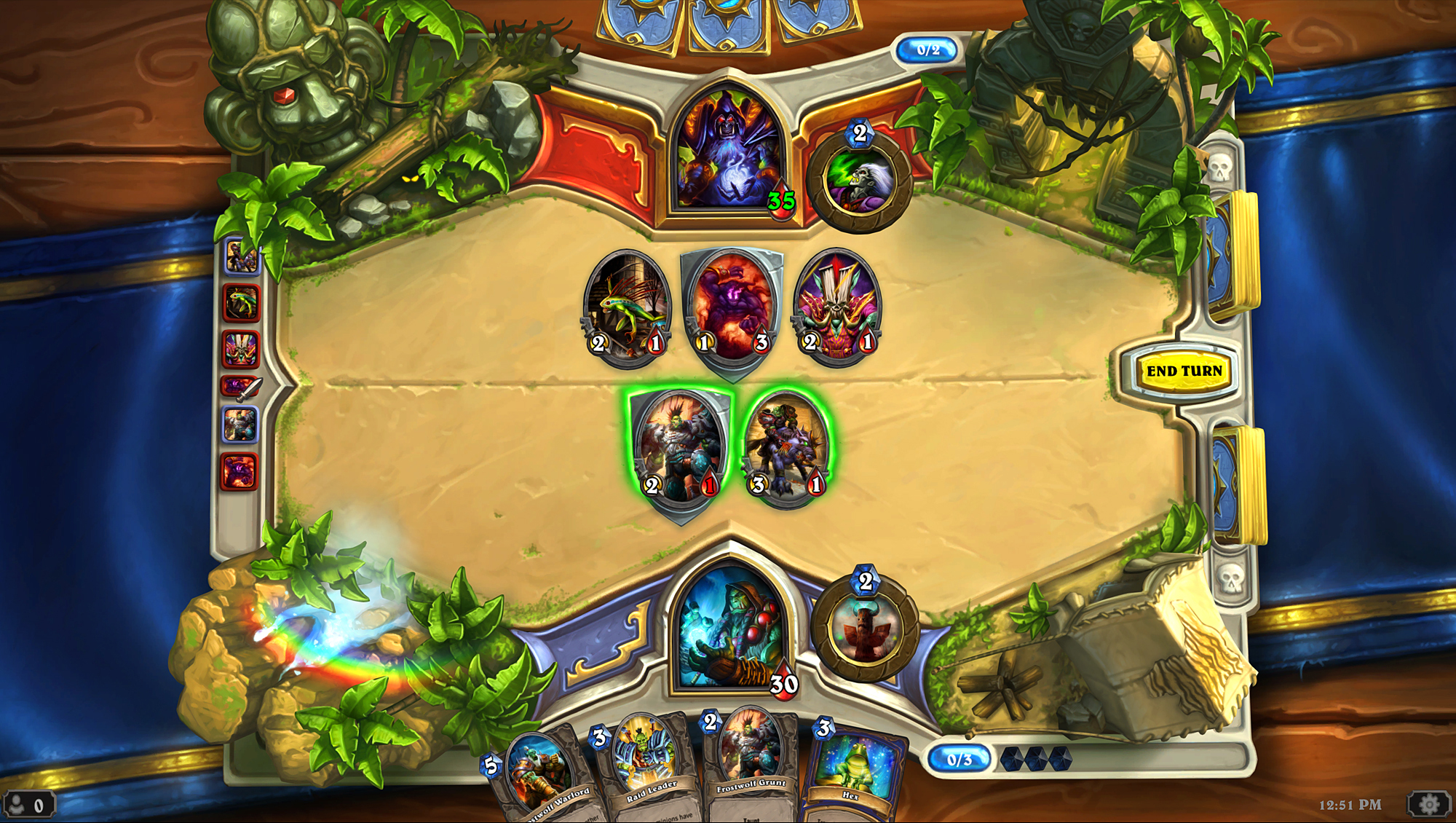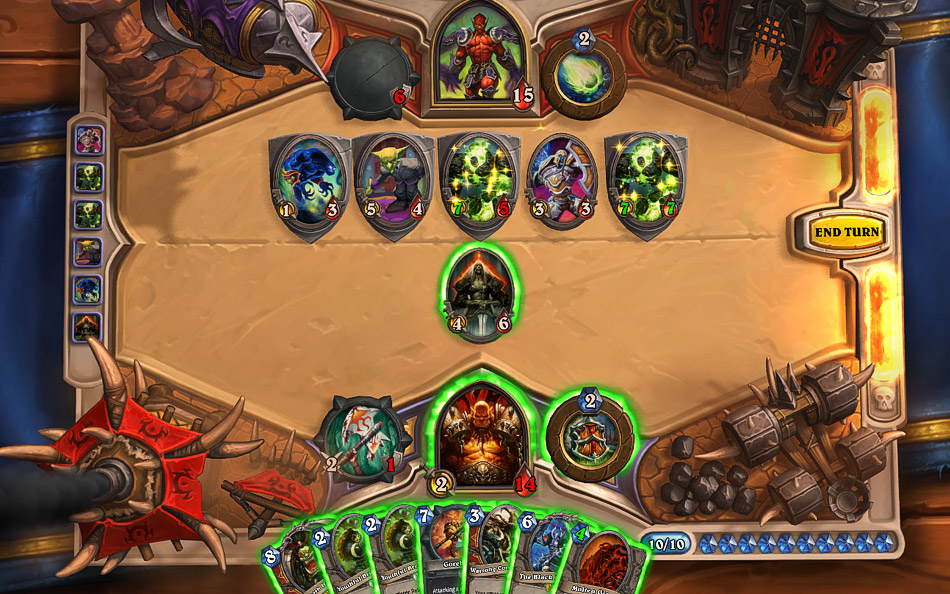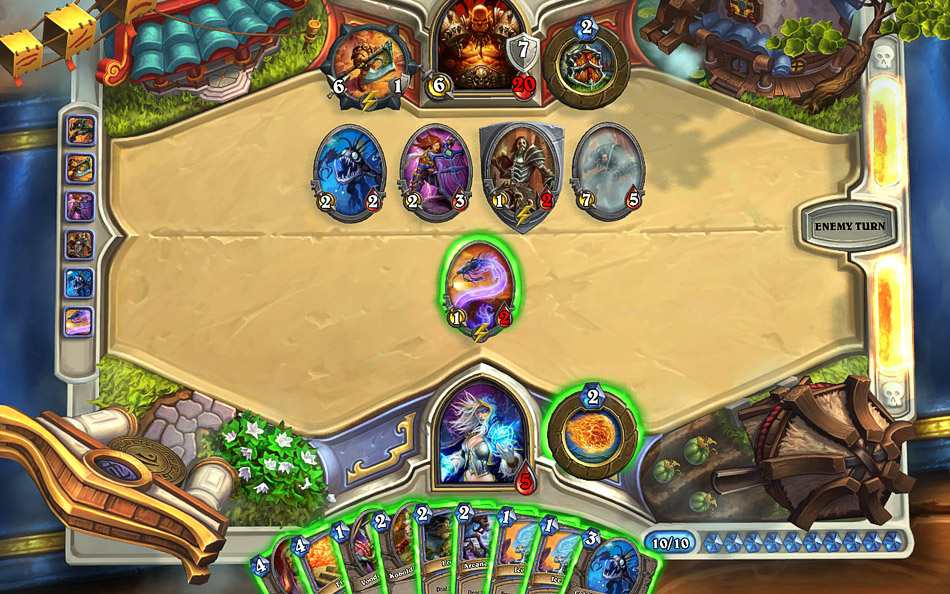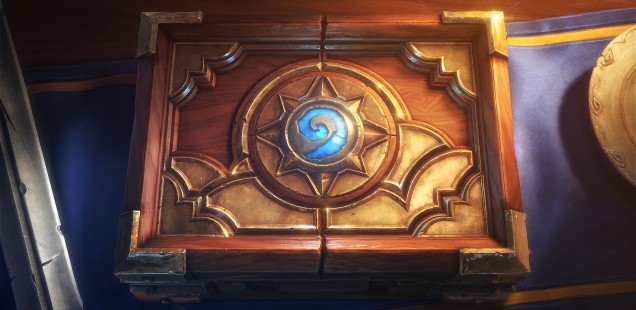
Game Thoughts: Hearthstone
Or: The Politics of Free. By Joe Köller.
Hearthstone is a free-to-play trading card game developed by Blizzard. Or is that the term that’s trademarked by Magic: The Gathering? In that case it’s a collectible card game. Unless it’s the other way around. Either way, it’s the kind of game where you build decks from an ever-growing collection of cards and face down opponents by taking it in turns drawing and playing said cards to summon minions or cast spells.
Hearthstone has also made me think about free-to-play mechanics. I’d like to start this off by describing the process of opening a booster pack in the game, because somebody should really record for posterity how much care went into creating a kind of virtual New Car(d) smell here. Like a lot of these games, Hearthstone relies on selling you small sets of random cards to make the process of acquiring new strategic building blocks both exciting and unreliable. Unlike other such games, Hearthstone combines the tried and tested model of getting people to spend large amounts of cash in tiny increments with free-to-play mechanics – a match made in heaven. You can buy these booster packs slowly, using game currency, or quickly, using real money.
What’s interesting about this is the way Hearthstone presents the value of its own proposition. When you buy one of these booster packs, the game doesn’t simply announce what five cards you got, oh no. Opening these packs – an act that is perfectly unnecessary in a digital environment – is afforded a menu screen of its own, most of it taken up by an ornate altar with a pack-shaped indentation in its center. Dragging your prize from the storage area over the altar causes its carvings to light up with a blue glow. After dropping it on there, the pack jumps towards the screen and explodes in a rain of golden sparks, at which point the five cards fly out and you turn them over one by one by clicking on them. A good find causes the narrator to excitedly announce the card’s designated rarity.
Every step of this process is crisply animated, too. When examining your spoils, the game doesn’t just instantly show the other side of the card. Each spins around, reduced to a slim line when it faces sideways and then coming into view again with the front facing your way. Dragging the pack around causes it to tilt back and forth a little, to give it a feeling of heft. The game tries to give all its cards a sense of weight the same way. Summoning minions, for instance, mirrors the act of throwing them on a table by first having the card hover up towards the screen from its default height before dropping the creature on the playing field with a satisfying thump (bigger creatures even get a louder landing). As strange as it sounds, a lot of effort has clearly gone into showing these flat play pieces as something three-dimensional, something worn, something real, not virtual.
And It works. I can’t decide whether that’s the best or the worst thing about it: it’s certainly a spectacular triumph of crafting convincing digital objects, but I’m having a hard time appreciating them because of their entanglement in the business plan behind the game. Even if part of their purpose is to make playing the game feel good, their end goal is to make me feel good about spending money on just about the only thing less financially sound than trading cards: digital trading cards.
This isn’t about lecturing you on the evils of free-to-play systems: It’s not the fact that Heartstone relies on such purchases for profit that upsets me, it’s how closely, and elegantly, they are tied to its mechanics. Whereas games that limit their wares primarily to visual customization almost inevitably end up becoming accidental critiques of capitalism by festooning their biggest spenders with the most garish and ridiculous of accessories, Hearthstone has you buying access to strategic resources, effectively recreating the free market lie of equal opportunity.
If you decide not to spend money on it, the game makes you fight at a permanent disadvantage while claiming to have given you every chance to win. Should you lose, it’s because of your strategy. Or because you made the wrong decisions in that match. Or bad luck. It’s because you drew the wrong cards, played the wrong cards, put the wrong cards in your deck. Not because you don’t even have the right cards, this is a fair fight after all. This is where Hearthstone lies to you. It’s not some unrelated contest of skill for which you can invest in a colorful wardrobe, it’s an uphill battle towards earning a fair match, maybe, eventually. Hearthstone subjects you to a deliberately fractured experience with the option of paying to complete it.
It isn’t necessary to buy cards in order to play the game or even do well, no, but its design still heavily encourages it. The streamlined mana economics of the game, for instance, favor big, expensive cards. In Magic these are generally a risky deal since you rely not only on drawing the card itself, but also on drawing enough land cards, which generate mana, to get to use it. You can improve your odds by including more land cards in your deck or throwing in spells that generate mana, let you play more land cards, etc., but both of those take up important space and it’s usually better to use something cheaper but more reliable instead.
In Hearthstone, the economic progression is automated: You gain one new mana crystal, the equivalent to land cards, in each of your turns, up to a maximum of ten. Which means that unless you suffer an early loss, you’ll soon be able to play any card in your deck, making it prudent to include a couple of heavy hitters to capitalize on the opportunity. In that regard, however, the collection of basic cards the game gives you has got nothing on the menagerie of rares vying for your attention, and money.
Free cards peter out around seven mana, which gives you a no-thrills minion with seven points in attack and defense. In the other corner? Eight mana for a 7/7 minion that also grows stronger with every passing turn. Nine mana for a 4/12 minion that gives you extra cards each turn. Ten mana for a 12/12 dragon that destroys every other minion on the field (and also makes you discard your hand).
The importance of individual cards is further enhanced by Hearthstone’s fixed, not to mention rather small deck size, the ability of minions to freely attack each other (instead of each player choosing attackers and defenders) and the fact that, barring one or two exceptions, used spells and killed minions stay gone, with no chance to recycle or resurrect them. The limited amount of resources you take into a fight makes running out of tricks a very real possibility, another reason to have a few aces up your sleeve.
At the best of times, it also gives the game a delightfully chess-like feeling. Apart from reducing your opponent’s health points to zero, your main focus is often to take out as many of their cards as possible without suffering egregious losses in the process. Best to save spells that instantly take out minions for late in the game, when you’ll really need them. Best to beat up small enemies with your big fighters and gang up on your opponent’s champions with your expendables.
This is perhaps Hearthstone’s most clever trick: it’s a great game. Of course it is, if it was frustrating or boring it wouldn’t get to sink its hooks into you. The insidious thing about the game isn’t that it’s ruthlessly nickle-and-diming you at every turn, or that it openly favors paying customers. It’s that it understands to hide its intentions so damn well, comes so close to being a fair environment it convinces you to stay. Because with luck and cunning, you do well enough even without those fancy rare cards, even beat some people who throw them at you. Until, every so often, you wind up in a particularly close match and, at the last second, your opponent pulls a Deathwing on you. Or Lord Jaraxxus. And Hearthstone reminds you that, oh, wouldn’t it be nice to also have one of those?
These moments are rare, so as not to drive you away, but just frequent enough to serve as a nagging reminder. Considering the lavish procedure of acquiring new cards, there’s not a doubt in my mind that an equal amount of thought has gone into tweaking the balance of the game to make sure basic decks will take you far, but only so far, and then leave you craving more powerful tools. It’s easy to knock bad free-to-play, with all its obvious cash grabs and design walls, but good free-to-play games, the well-oiled machines of Candy Crush, Clash of Clans and now Hearthstone, are infinitely more nefarious. The science behind them follows a line of thought that takes gaming so close to gambling the extra b really isn’t worth the effort. It’s gross.
In one of the most important features written last year, Drew Dixon criticized games writing’s usage of the word “addictive” as praise, noting, quite rightly, that an addiction isn’t something positive. It doesn’t seem like he was heard though. We still praise games for their ability to take hold of us, and blame a lack of self-control when our commitment reaches unhealthy levels, without bringing into question how deliberate design might be complicit in it. Meanwhile, games continue to explore reward cycles, how to craft compulsion and how to create habits. Their rising interest to keep you paying as well as playing has only made this side of game design more questionable. It’s bewildering to me that the existence of these enormous schemes to keep people sedately pushing the same buttons forever, endlessly wasting time and money, isn’t widely ostracized yet. This must be how Ian Bogost feels.
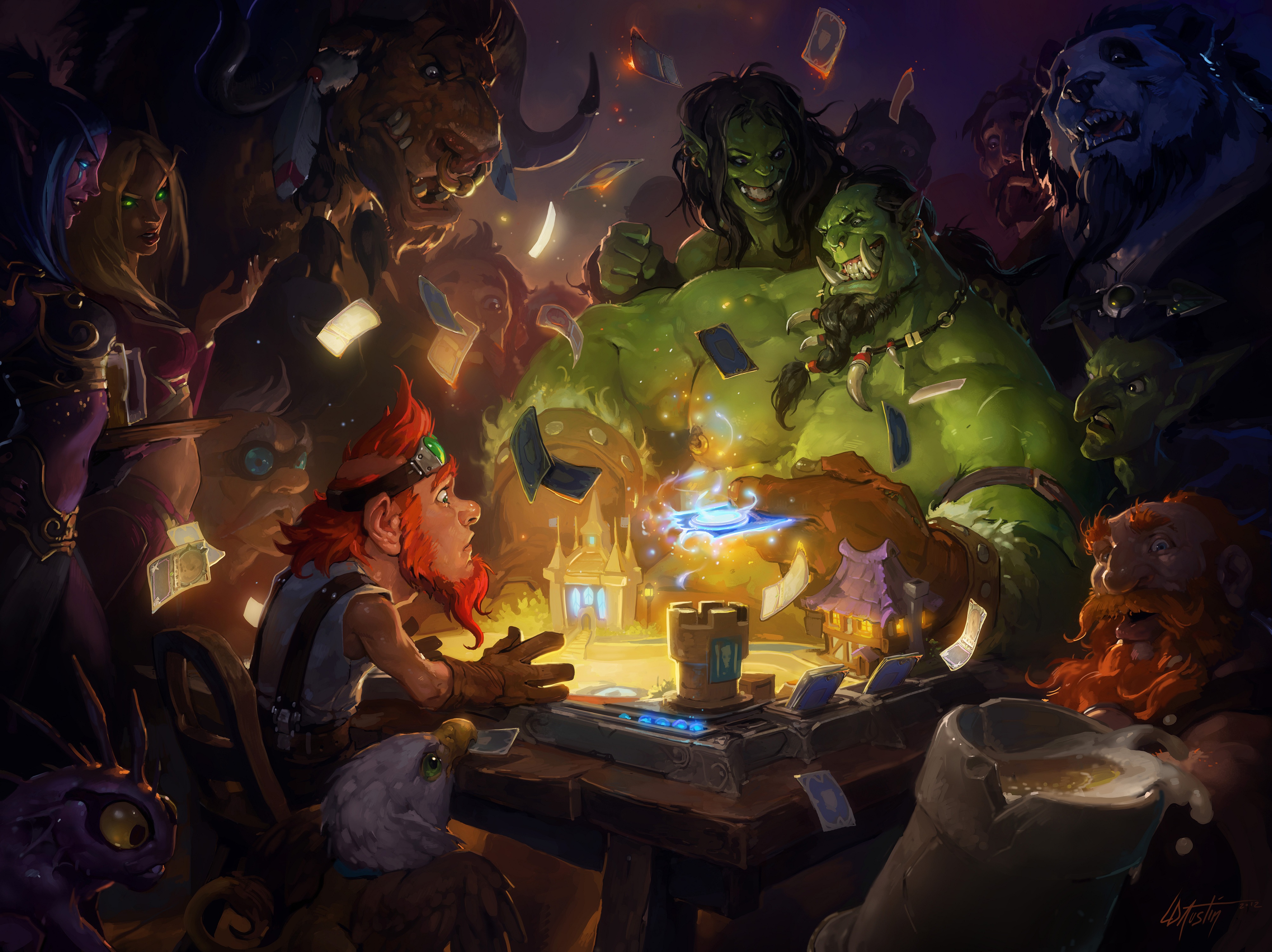 Perhaps it sounds like I am cynically disregarding the free will and critical thought of millions of people to explain why they’d agree to take part in all this, but it’s not that I am ignoring their capacity for resistance, it’s that these machines have been built to incorporate it into their own plans. It’s tempting to think of playing an aggressively monetized free-to-play game without paying anything as a way of getting one over on the developers, like you are cheating them out of money by having fun for free. The truth is that even when you aren’t directly feeding this system, you are still keeping it alive by sticking around. You are giving its customers somebody to play against, and to feel better than. Rare cards are only valuable if there’s somebody around who doesn’t have them.
Perhaps it sounds like I am cynically disregarding the free will and critical thought of millions of people to explain why they’d agree to take part in all this, but it’s not that I am ignoring their capacity for resistance, it’s that these machines have been built to incorporate it into their own plans. It’s tempting to think of playing an aggressively monetized free-to-play game without paying anything as a way of getting one over on the developers, like you are cheating them out of money by having fun for free. The truth is that even when you aren’t directly feeding this system, you are still keeping it alive by sticking around. You are giving its customers somebody to play against, and to feel better than. Rare cards are only valuable if there’s somebody around who doesn’t have them.
None of this is to say that Hearthstone isn’t an enjoyable experience, or that you shouldn’t play it, in moderation, but simply that it deserves skepticism, not unreserved enthusiasm. It’s hard to say at what point exactly games turn into slot machines, but it’s clear that they’ve started blending into each other. You’ll ultimately know better than me whether Hearthstone is something you’d enjoy, and can keep a healthy relationship with, but I recommend staying away just to be safe.
Joe Köller is the current Editor-in-Chief of Haywire Magazine, German correspondent for Critical Distance, and irregular contributor to German sites such as Video Game Tourism, Superlevel, and WASD. You can follow him on Twitter, and support him on Patreon.
